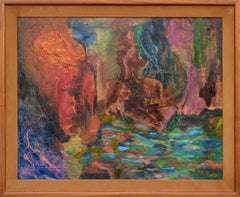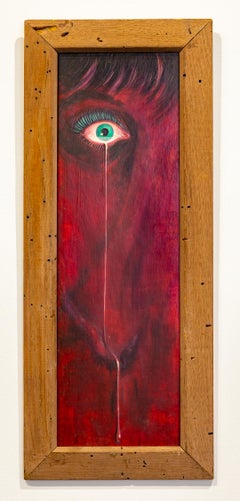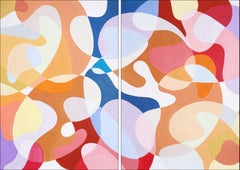Rose Herzog Paintings
Rose Herzog was a painter from Los Angeles, California. Herzog was represented by J. Cook Studios, Indiana.
(Biography provided by Robert Azensky Fine Art)
to
1
1
Overall Width
to
Overall Height
to
1
1
1
1
1
1
1
1
1
1
784
712
707
702
1
Artist: Rose Herzog
Shimmering Pond in the Woods - Surrealist Abstract 1960s
By Rose Herzog
Located in Soquel, CA
Shimmering Pond in the Woods - Surrealist Abstract 1960s
Highly textured abstract composition by Rose Herzog (American, mid-20th Century). A multicolored pond is shown in the middle...
Category
1960s American Modern Rose Herzog Paintings
Materials
Cotton, Masonite, Mixed Media, Oil, Tissue Paper
$1,657 Sale Price
35% Off
Related Items
"Don't Cry Long" Abstracted and Distorted Self-Portrait, One Crying Eye
Located in Detroit, MI
"Don't Cry Long" is a self-portrait of the artist and an unusual one at that in which the artist portrays herself shedding tears. Perhaps it is an expression of some grief experienced by Ms. Woodlock, but it also admonishes her to not "Cry Long" while at the same time poking fun because of her elongated face and the one lone "long" tear tracing a pattern down her face. In addition to self-portraits, Ethelyn painted commissioned portraits. In this painting her head is cocked and her famous bangs hang down her forehead. Compare two self-portraits, “Up From Under”, and “M’Eyes" to "Don't Cry Long." The major differences are the close facial view and the brilliant blood red paint that fills the entire canvas.
This painting is included in the book, "Dreams Have Wings: An Artist's Journey into Magic and Mystery" printed in the United States, 1985. She describes "Don't Cry Long" as showing how funny looking we are, if we cry too long.
Ethelyn Woodlock...
Category
Mid-20th Century American Modern Rose Herzog Paintings
Materials
Oil, Masonite
Rainbow Curves, Painter's Palette Translucent Shapes, Large Diptych on Paper
By Ryan Rivadeneyra
Located in Barcelona, ES
This is a modernist-inspired painting, drawing influence from the bold creativity of 1950s, 60s, and 70s art. The composition features overlapping painter’s palette silhouettes, crea...
Category
2010s American Modern Rose Herzog Paintings
Materials
Oil, Paper
$800 Sale Price
20% Off
H 40 in W 55.2 in
Large Hudson River Figurative Modernist Landscape Oil Painting Edward Avedisian
By Edward Avedisian
Located in Surfside, FL
Edward Avedisian ( 1936-2007 )
Gouache or oil on paper, 3 guys around a car,
hand signed in paint lower left,
Measures 30"x 22.5"
Edward Avedisian (June 15, 1936, Lowell, Massachusetts – August 17, 2007, Philmont, New York) was an American abstract painter who came into prominence during the 1960s. His work was initially associated with Color field painting and in the late 1960s with Lyrical Abstraction and Abstract Expressionism.
He studied art at the School of the Museum of Fine Arts, Boston. By the late 1950s he moved to New York City. Between 1958 and 1963 Avedisian had six solo shows in New York. In 1958 he initially showed at the Hansa Gallery, then he had three shows at the Tibor de Nagy Gallery and in 1962 and 1963 at the Robert Elkon Gallery. He continued to show at the Robert Elkon Gallery almost every year until 1975.
During the 1960s his work was broadly visible in the contemporary art world. He joined the dynamic art scene in Greenwich Village, frequenting the Cedar Tavern on Tenth Street, associating with the critic Clement Greenberg, and joining a new generation of abstract artists, such as Darby Bannard, Kenneth Noland, Jules Olitski, and Larry Poons.
Avedisian was among the leading figures to emerge in the New York art world during the 1960s. An artist who mixed the hot colors of Pop Art with the cool, more analytical qualities of Color Field painting, he was instrumental in the exploration of new abstract methods to examine the primacy of optical experience.
One of his paintings was appeared on the cover of Artforum, in 1969, his work was included in the 1965 Op Art The Responsive Eye exhibition at the Museum of Modern Art and in four annuals at the Whitney Museum of American Art. His paintings were widely sought after by collectors and acquired by major museums in New York and elsewhere. He has been exhibited in prominent galleries, such as the Anita Shapolsky Gallery and the Berry Campbell Gallery in New York City. Edward Avedisian was known for his brightly colored, boldly composed canvases that combined Minimalism's rigor, Pop art exuberance and the saturated tones of Color Field painting.
Roberta Smith of the NYT writes of Avedesian: "Edward Avedisian helped establish the hotly colored, but emotionally cool, abstract painting that succeeded Abstract Expressionism in the early 1960s. This young luminary harnessed elements of minimalism, pop, and color field painting to create prominent works of epic proportions that energized the New York art scene of the time." In 1996 Avedisian showed his paintings from the 1960s at the Mitchell Algus Gallery, then in SoHo. His last show, dominated by recent landscapes, was in 2003 at the Algus gallery, now in Chelsea.
Selected Exhibitions:
Op Art: The Responsive Eye, at the Museum of Modern Art,
Whitney Museum’s Young America 1965
Expo 67, held in Montreal, Canada.
Six Painters (along with Darby Bannard, Dan Christensen, Ron Davis...
Category
20th Century American Modern Rose Herzog Paintings
Materials
Oil, Gouache, Archival Paper
Without Beginning Without End, Two-Sided Cubist Painting by William Littlefield
Located in Long Island City, NY
Artist: William Littlefield, American (1902 - 1969)
Title: Still Life and Abstract
Year: 1950 & 1954
Medium: Double-Sided Oil on Masonite, signed and dated both sides
Size: 22 x 28 i...
Category
1950s American Modern Rose Herzog Paintings
Materials
Masonite, Oil
Figurative Cubist Surrealist Abstraction Mid 20th Century American Modern Large
By O. Louis Guglielmi
Located in New York, NY
Figurative Cubist Surrealist Abstraction Mid 20th Century American Modern Large
O. Louis Guglielmi (1906 - 1956)
OBSESSIVE THEME
44 x 33 inches
Oil on canvas
Signed and dated '48 lo...
Category
1940s American Modern Rose Herzog Paintings
Materials
Canvas, Oil
$50,000
H 47 in W 36 in D 2 in
Modern Abstract Painting by Ted Gilien
By Ted Gilien
Located in Long Island City, NY
Artist: Ted Gilien, American (1914 - 1967)
Title: Untitled
Year: circa 1960
Medium: Oil on Masonite, signed l.l.
Size: 24 x 32 inches [60.96 x 81.28 cm]
Category
1960s American Modern Rose Herzog Paintings
Materials
Masonite, Oil
"Backstage, Ambassador" Broadway Theatre NYC Mid-century Modern Modernist Cubist
By Sam Norkin
Located in New York, NY
"Backstage, Ambassador" Broadway Theatre NYC Mid-century Modern Modernist CubistSigned lower left, titled on the stretcher.
Norkin was a Brooklyn, Ne...
Category
1940s American Modern Rose Herzog Paintings
Materials
Canvas, Oil
Carl Holty Abstract Oil Painting "Riviera" in Primary Colors
By Carl Robert Holty
Located in Detroit, MI
"Riviera" is an exquisite painting of American Modern - primary colors actively composed in energetic movement and structure on the painted surface. These colors formulate the painting, play both for and against each other and create a lively surface with hints of either an architectural structure or freeway. This painting hints to future Modernists such as Richard Diebenkorn "Driveway" and David Hockney "Garrowby." Unframed the piece measures 18 x 24.
"Riviera" is signed on lower left. On verso is Provenance of over 70 years, 3 galleries in New York and one in Detroit, Michigan: Andrew Crispo Gallery, Sid Deutsch Gallery and Linda Hyman Gallery in New York and Collected Detroit Gallery in Detroit, Michigan.
Abstractionist Carl Robert Holty was known for his biomorphic abstract forms as well as the geometric abstractions he painted with his vibrant color palette. Born in Frieburg, Germany his family immigrated to the United States settling in Wisconsin. In 1919, he enrolled at the Art Institute of Chicago, and shortly thereafter attended the Parsons School of Design. He spent a short time at the National Academy of Design and studied with Francis Coates Jones...
Category
Mid-20th Century American Modern Rose Herzog Paintings
Materials
Oil, Canvas
$24,000
H 22 in W 28 in
Untitled-006 abstract painting by Fred Martin
By Fred Martin
Located in Hudson, NY
Exhibited:
2003 Oakland Museum of California "Fred Martin Retrospective"
A native Californian, Fred Martin was born in San Francisco in 1927, and received both his BA (1949) and MA (1954) from University of California, Berkley. At the San Francisco Art Institute Martin studied with Clyfford Still, Mark Rothko and David Park...
Category
1970s American Modern Rose Herzog Paintings
Materials
Masonite, Pastel, Acrylic
Cubist Musician, Abstracted Figure by American Modernist in France Woman Artist
Located in Norwich, GB
A touch of Chagall and a lot of individuality in this singular work by American modernist artist Genevieve. A free spirit, Genevieve White, born 1913 in Idaho, left home at 14 to mov...
Category
1970s American Modern Rose Herzog Paintings
Materials
Canvas, Mixed Media, Oil
$820
H 27.96 in W 24.02 in D 1.97 in
Newcomb Macklin antique carved custom gilt mirror/ picture frame
Located in Wilton Manors, FL
Abstract painting, ca. 1970s measures 25 x 30 inches. Oil on canvas, unsigned.
Stunning modernist custom carved picture frame by Newcomb Macklin. ca. 1950 production. Long, elegant...
Category
Mid-20th Century American Modern Rose Herzog Paintings
Materials
Canvas, Wood, Oil
$2,000
H 29.63 in W 34.63 in D 2.38 in
A Dynamic Mid-Century Modern Horse Race Painting by Chicago Artist, Rudolph Pen
Located in Chicago, IL
A dynamic, Mid-Century Modern horse race painting by noted Chicago artist, Rudolph Pen. Artwork size: 27" x 23"; Framed size: 27 1/2" x 23 1/2". Signed "Pen" lower right. Provenan...
Category
Mid-20th Century American Modern Rose Herzog Paintings
Materials
Masonite, Oil
$1,600
H 27 in W 23 in D 2 in
Rose Herzog paintings for sale on 1stDibs.
Find a wide variety of authentic Rose Herzog paintings available for sale on 1stDibs. You can also browse by medium to find art by Rose Herzog in cotton, fabric, masonite and more. Much of the original work by this artist or collective was created during the 1960s and is mostly associated with the abstract style. Not every interior allows for large Rose Herzog paintings, so small editions measuring 34 inches across are available. Customers who are interested in this artist might also find the work of Toma Yovanovich, Ronald Ahlstrom, and Doris Warner. Rose Herzog paintings prices can differ depending upon medium, time period and other attributes. On 1stDibs, the price for these items starts at $1,450 and tops out at $1,450, while the average work can sell for $1,450.


